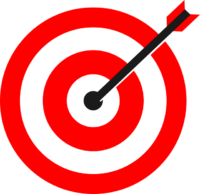
I look at a lot of radio station websites, and inevitably, they almost all suffer from the same problem: They have too much crap on the homepage. This omnipresent problem is due in large part to the fact that when radio stations are looking for inspiration, they look at the websites of other radio stations. Add into the mix that many broadcast companies use the same template for the websites of all their radio stations, and it’s easy to see how overcrowded homepages spread across the industry like an infectious disease. (Side Note: Radio, when it comes to digital, please stop asking, “What are other radio stations doing?” and start asking, “What are companies in other industries doing?”)
So we have radio station homepages crammed full of slideshows touting the upcoming Dunkin’ Donuts promotion or whatever C-level band is playing in town this weekend; widgets that send people back to Facebook (after going through all the trouble of getting people to your website, I have no idea why you would then want to send them back into the arms of Mark Zuckerberg); and the weather forecast, as if there weren’t already a million apps for that.
Ironically, despite this everything-but-the-kitchen-sink approach, many radio stations are missing some of the most important elements on their homepages, including: cues about what type of music or talk can be heard on the airwaves, such as a description of the format or pictures of core artists; an indication of where your radio station is located (only people in your market can hear your airwaves, but anybody from anywhere can visit your website); and a big, fat, obvious link for people who are interested in advertising on the station (if people want to give you money, make it as easy as possible for them).
Not All Website Content is Equal
The problem with crowding your radio station’s homepage with concert listings and the latest celebrity news is that it assumes that all website content plays the same role in your digital strategy, and is therefore equally worthy of being on the homepage. But not all content plays the same role.
One of the most important questions you can ask when designing your radio station’s digital strategy is, “When people come to our website, what do we want them to do?” When I ask radio station staffs that question, all too often it turns out to be a stumper. I hear vague answers like “read stuff” or “spend lots of time on the site” or “engage.” None of these things will directly impact your radio station’s bottom line.
 Instead, radio broadcasters should articulate specific, quantifiable goals that can affect the station’s bottom line. For example, you may want website visitors to:
Instead, radio broadcasters should articulate specific, quantifiable goals that can affect the station’s bottom line. For example, you may want website visitors to:
- Stream the station
- Join the email list
- Click on an ad
- Enter a contest
- Buy tickets to a station event
- Make a donation
- Request information about advertising
When I see a radio station with an overcrowded homepage, it’s often a symptom of a larger issue: The staff has not identified their digital goals; they don’t know what they want people to do when they come to the website.
Once you’ve identified the goals of your website, you can start dividing your online content into to different categories, based on the purpose that this content serves in leading people towards these goals. The categories, in turn, determine the placement of the content on your station’s website, including which are worthy of being on the homepage.
Content to Get People to the Website
The first category is content that is designed to get people to come to your radio station’s website. This is the content that is shared on social media, sent in email blasts, and optimized to show up in search engine results. The hope is that people see this content somewhere else and are compelled to click on a link, landing on your webpage. This content is free (not behind a paywall) and open (not behind a form). To drive traffic to your radio station’s website, you’ll need a steady stream of new content — you can’t just share the concert listings page over and over — so what we’re talking about here is the station’s blog or news content.
Radio stations tend to get more “direct traffic” than other companies. In other words, more people hear the radio station talk about their website on the air, open a browser, and type the station’s URL directly into the navigation bar as opposed to clicking on a link and coming through a side door like a blogpost. That’s why radio stations tend to think of blogposts as a place to send people when they come through the front door. But that’s not their purpose; blogposts are there to drive traffic through the side door.
Once you’ve gotten people to your radio station’s website, this content has served its purpose. Now, you want to direct them to one of the goals identified above. Steering them to another blogpost just gets in the way of those goals. When somebody enters your house, you don’t immediately send them to the side door. That’s why this type of content does not belong on your homepage.
Content to Steer People Towards the Goals
Here at Jacobs Media, the main goal of our website is to capture people’s email addresses. Once a blogpost like this one has brought people to our site, we lead them towards a longer, more in-depth piece of content, like a webinar recording, a guide, or research results. We describe these pieces of content as “freemium” — they’re free to access, but unlike our blogposts, they’re not open. We close them off with a form that asks for your email address.
As you can see, our blogposts serve a different purpose (getting people to our website) than our freemium content (capturing people’s email addresses). For your radio station, some of your digital goals may involve freemium content (such as the goal of “capturing email addresses”) while others may not, because there’s just a simple click involved (such as the goal of “streaming the station”).
Content or calls to action that achieve your station’s digital goals deserve a prominent — and arguably an exclusive — place on your homepage.
Content Behind a Paywall
Few radio stations are going to produce content that requires payment to access. The exceptions might be news stations. Getting people to purchase access to this content should be one of the primary digital goals of these stations, and this content should be featured accordingly.
Content That is Expected But Doesn’t Advance Goals
There will be some content that people expect to find on your radio station’s website but doesn’t advance your radio station’s goals. For example, people may want to see the concert calendar, read the DJ bios, or find the physical address of the station. It’s important to have this content on the site because visitors expect it, but this content should not be overtly called out. Allow people to navigate to it through your station’s main menu, but don’t feature it prominently on your homepage.
Most radio stations can do a lot towards advancing their digital strategies by first identifying explicit goals, and then removing things from their homepages that don’t steer visitors towards those goals. Take another look at your radio station’s homepage and see if it suffers from overcrowding. If so, fix it.
- A Simple Digital Treat to Thank Your Radio Listeners This Thanksgiving - November 13, 2023
- Interview Questions When Hiring Your Radio Station’s Next Digital Marketing Manager - November 6, 2023
- A Radio Conversation with ChatGPT: Part 2 – Promotions - October 30, 2023





I’ve stopped going to radio stations’ websites for this reason. That and the fact that when I want to contact them, I don’t want to fill out a form. Give me a phone number and physical address.
Thanks for reading, Scott. Yes, radio stations should make it easy for people to contact them in whatever way the wish to do so.